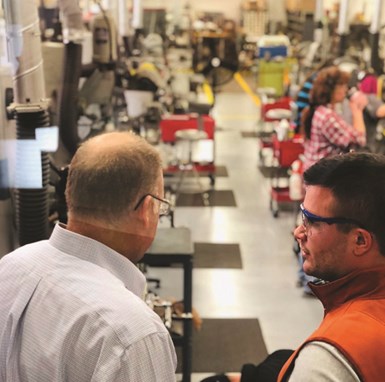COVID-19 Effects on the Manufacturing Workforce
How has COVID-19 actually affected the manufacturing workforce? Have employer needs changed? Are the changes here to stay?

PMPA member Linas Biliunas, from Martindale Electric Co., discusses workforce needs with Taylor Evans.
Workforce is an evergreen issue for the manufacturing industry. With the changes in our COVID-19 world, some companies need more employees and some had to layoff employees. I talked to Taylor Evans from Rust Belt Recruiting to get his perspective.
I have to share how Taylor started his company. On the day Taylor and his wife found out they were pregnant with their second child, his wife told him to quit his job and start the recruiting company. Wow! Thereafter, Rust Belt Recruiting began serving the manufacturing industry by recruiting and placing temporary-to-hire and direct-hire employees.
As I am not familiar with the recruiting process, I asked Taylor how it worked. A temp-to-hire employee works for a company for 90 days, is on Rust Belt’s payroll, and is eligible for hire after the 90 days. This way the company can determine if the employee is a good fit before directly hiring them. Direct hire is what it sounds like — Rust Belt finds candidates and the company can hire them.
So how has COVID-19 actually affected the manufacturing workforce? Have employer needs changed? Are the changes here to stay? Taylor sees COVID-19 affecting the manufacturing workforce in several ways.
Short Term
From March to the writing of this article, the workforce has seen a dramatic change. Some shops are dependent on the automobile industry or other industries that slowed and had to lay off employees. There are several shops that supply the medical field, were awarded ventilator part jobs or make other virus essential parts and they are actively hiring.
Long Term
Eventually, the economy will get back to some semblance of “normal” and the people in other industries (such as retail, restaurants, or hospitality) who were furloughed or laid off may see manufacturing in a different light. Manufacturing kept going while other industries came to a standstill. Manufacturing is essential and it is everywhere. The world needs manufacturing to survive. According to Taylor, “There may be a renaissance of sorts where people view manufacturing jobs as stable and desirable.”
Additionally, in about six to 18 months, we could see a change in the supply chain and more reshoring. These changes would bring a lot of work back and the manufacturers are going to need additional employees.
Silver Lining
Many of us look for the silver lining when things look bad. When I asked Taylor what he thought the COVID-19 silver lining is with regard to the manufacturing workforce he boiled it down to three outcomes:
- A greater appreciation for the importance of manufacturing
- A resurgence in the manufacturing work in our country
- An awareness that spans all age groups about the viability and the security that can come with a manufacturing job — unlike in other industries.
As Taylor summed it up, “Those three outcomes could be really exciting and I hope that high school guidance counselors and school leaders begin to encourage their students to consider a manufacturing career path.”
About the Author
Carli Kistler-Miller, MBA, has over 20 years of experience with communications, event/meeting planning, marketing, writing and operations. Email cmiller@pmpa.org.
Related Content
Emerging Leader's Dedication to Education
Instilling confidence throughout a shop floor can do wonders for company morale while increasing productivity.
Read MoreThe Value of Aligning Efforts to Promote Manufacturing Careers
Successfully building the next generation of manufacturers requires a team effort between employers, educators and parents. Each of these three groups has a tremendous impact on young people’s career decisions. Without the support of all three, we are unlikely to bridge the skilled labor shortage that threatens the future growth of our industry.
Read MoreStrengthening Manufacturing Workplaces Through Active Listening
A good strategy to weather the storms of manufacturing market upheavals and unpredictable factors is to commit to continuous, active employee listening.
Read MoreManufacturing Skills Training: Virginia Martinez and Laiken Carrillo
Roles of Women in Manufacturing Series: A precision machining career starts with skills. Virginia and Laiken share their journey and how they help prepare the next generation.
Read MoreRead Next
A Tooling Workshop Worth a Visit
Marubeni Citizen-Cincom’s tooling and accessory workshop offers a chance to learn more about ancillary devices that can boost machining efficiency and capability.
Read MoreSeeing Automated Workpiece Measurement in Real Time
User-friendly inspection software for CNC machining centers was shown at IMTS 2024 monitoring measurements between and after machining while performing SPC based on recorded measurement values.
Read MoreDo You Have Single Points of Failure?
Plans need to be in place before a catastrophic event occurs.
Read More






















